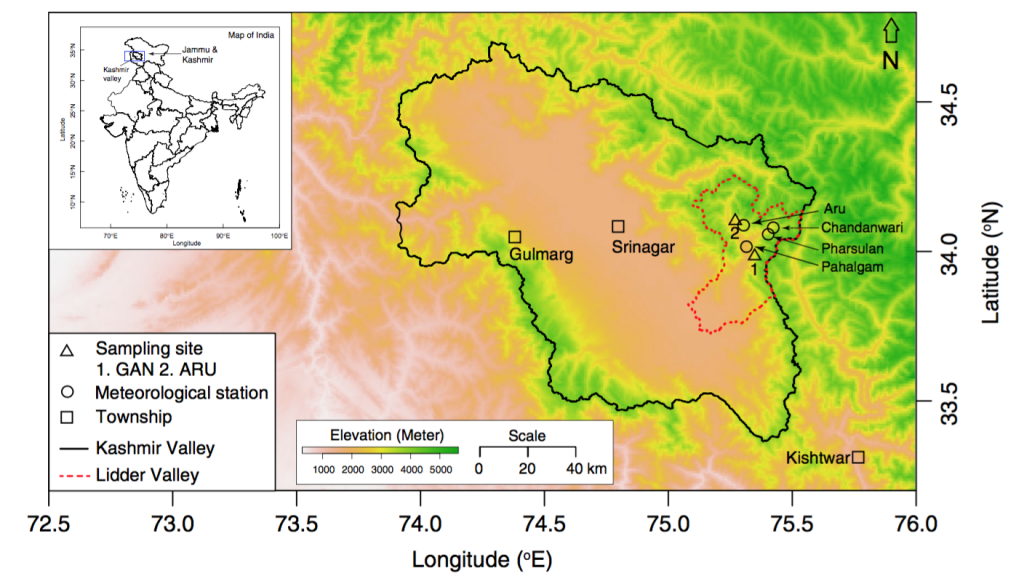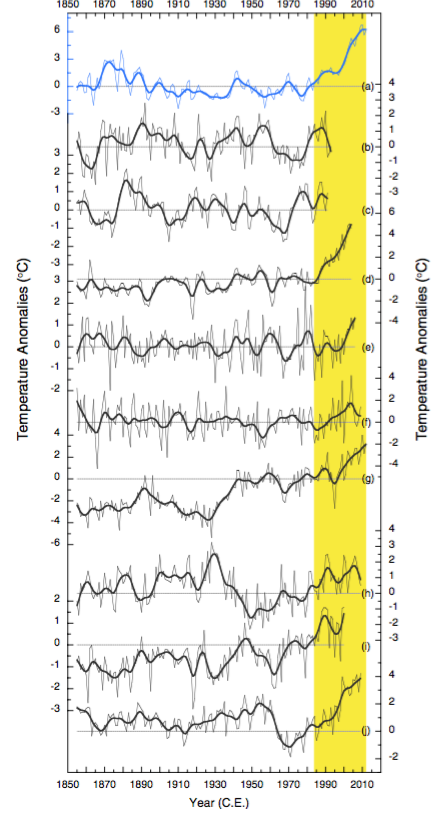The Wooster Tree Ring Lab collaborated on a publication describing the recent thermal history of the Lidder Valley, Northwest Himalaya. Dr. Santosh Shah, the lead author, is a multitalented paleoclimatologist at the Birbal Sahni Institute of Palaeosciences in Locknow, India. He and his colleagues led the study that appeared in Climate Dynamics and is titled: A winter temperature reconstruction for the Lidder Valley, Kashmir, Northwest Himalaya based on tree-rings of Pinus wallichiana. Here is the abstract from the study:
Abstract: A regional, 175 year long, tree-ring width chronology (spanning 1840–2014 C.E.) was developed for Pinus wallichiana A. B. Jacks. (Himalayan Blue pine) from the Lidder Valley, Kashmir, Northwest Himalaya. Simple and seasonal correlation analysis (SEASCORR) with monthly climate records demonstrates a significant direct positive relationship of tree growth with winter temperature. A linear regression model explains 64% of the total variance of the winter temperature and is used to reconstruct December–March temperatures back to 1855 C.E. The most noticeable feature of the reconstruction is a marked warming trend beginning in the late twentieth century and persisting through the present. This reconstruction was compared with instrumental records and other proxy based local and regional temperature reconstructions and generally agrees with the tree-ring records and is consistent with the marked loss of glacial ice over the last few decades. Spectral analysis reveals a periodicity likely associated with the Atlantic Multidecadal Oscillation and El Niño–Southern Oscillation. Spatial cor- relation patterns of sea surface temperatures with the observed and reconstructed winter temperatures are consistent with larger scale warming in the region.

Map showing the location of the study in the Lidder Valley in Kashmir, Northwest India.
The rivers of the Lidder Valley are fed by glaciers from the Himalaya, which are becoming increasingly impacted by climate change and population pressures. The people within the valley depends on the water from the rivers and managing the water in this rapidly warming region is an increasing challenge. The results in this work show the increasing pace of the recent warming (see figure below).

Temperature reconstructions (above) based on tree-rings for the Himalaya. The curve on the top is from the new publication.
Dr. Shah is now working on using tree-rings to reconstruct river flow in the region. This is work that he presented last year at World Dendro in Bhutan and which we are are also collaborators. We are grateful to Dr . Shah for introducing us to climate change research in the Himalaya AND for his help to our former students of the Wooster Tree Ring Lab.
Jeff Gunderson, who recently completed his masters thesis at The Ohio State University in Geography used tree-rings from the Peruvian Andes to reconstruct climate. Jeff collaborated with Dr. Shah who shared his computer code and guidance in calibrating his Peruvian tree-ring records.
.



The NASA GRACE satellites have been instrumental (ha ha!) in determining short-term water outflow (seasonally and over a couple of decades) from groundwater systems in northern India (and many other places, including the Great Plains and Central Valley of this country, for those interested in investigating). Their data point us to the areas where we are most likely to see climate-change-induced mass migrations, led by the confluence of large populations with traditional farming practices in borderline-desert environments.
The damage done, by changing groundwater flow, coupled with over-utilization, over the last few decades, will be the trigger for many large-scale population migrations, and consequent misery, over the coming years, migrations that we (as a world) are ill-equipped to deal with, politically or logistically. The loss of glaciers in the Himalaya is of particular concern because of the very large populations, across eastern and southern Asia, that rely on that steady flow of meltwater derived from them.
The Syrian civil war and migration was the first taste of this variety of climate consequence, and we are now beginning to see ripples of that in this hemisphere, too, although the western hemisphere migrations may never approach the scale of those east of the prime meridian, because of the unique geography of the Americas.
Looking at the data in the new study, above, I am always leery of looking for springtime trends of small magnitude, embedded in data sets that are wildly variable. A brief look at our springtime, mid-latitude, instrumental data from the OARDC, in Wooster, shows standard deviations (high and low T) of about this same order of magnitude (~6C). There is little doubt the environment is warming, and that tropical deforestation (around the world) may be one of the drivers in the wacky variations we are seeing developing in the El Niño cycle, as we toy with tropical water flow into and out of the atmosphere (which then messes with the monsoon conditions of South Asia). The study you’ve referenced, above, helps to reinforce that understanding, but I would like to know more about the absolute error involved in the analysis–can you do a post on that, Greg, or have one of your students do that?
What is really needed, beyond further scientific corroboration, is leadership, on the part of the developed world, to rapidly aid populations, in the developing world, on agricultural methods that will stave off the desperate mass migrations that will result from the collapse of traditional farming practices. We have watched the current administration cut-off much of this type of funding, in pursuit of triumphal potential wall-building, but only through mitigation of the original problem will be able to stabilize populations, keeping migration disasters at bay.